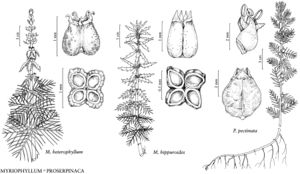Proserpinaca pectinata
Tabl. Encycl. 1: 214, plate 50, fig. 1. 1792.
Stems to 0.5 m. Leaves homomorphic, pectinate; petiole (0.4–) 0.8–4 (–6.5) mm; submersed leaves ovate in outline, 15–35 × 10–25 mm, segments 6–16, longest segment (7–) 12–14 (–18) mm; emersed leaves similar to submersed, transitional, elliptic to ovate in outline, (4–) 10–20 (–35) × (2–) 5–15 (–17) mm, segments (4–) 8–18 (–22), longest segment (1.4–) 2–6 (–8.5) mm. Inflorescences: bracteoles lanceolate to narrowly ovate, margins irregular, entire or broadly serrate to pinnatifid; primary bracteoles 1–3.8 × 0.3–0.9 mm, secondary bracteoles 0.7–1.4 × 0.2–0.7 mm. Flowers: sepals green to purple, shallowly triangular, 0.6–1 (–1.5) × 0.5–1.2 mm; petals to 0.2 mm; filaments to 1.7 mm; anthers yellow, widely oblong, 0.4–1 × 0.2–0.6 mm; pistil 1.6–2.8 mm; style to 0.5 mm; stigma pink to purple, lanceolate, to 1 mm, fimbriate. Fruits obtusely 3-angled in cross-section, 2.2–3.2 × 2–3.8 mm, margins rounded to slightly winged, faces widely ovate to shallowly triangular, surface smooth to ± rugose or ± papillate to ± tuberculate; sepals strongly accrescent, ascending with appressed margins. 2n = 14.
Phenology: Flowering and fruiting late Jun–Oct.
Habitat: Shores of lakes, ponds, rivers, streams, bogs, and marshes.
Elevation: 0–500 m.
Distribution
N.B., Nfld. and Labr. (Nfld.), N.S., Ala., Del., D.C., Fla., Ga., Ky., La., Maine, Md., Mass., Mich., Miss., N.H., N.J., N.Y., N.C., Pa., R.I., S.C., Tenn., Tex., Va., s Mexico, Central America
Discussion
Proserpinaca pectinata occurs in aquatic and semiaquatic habitats and displays little morphological variation across its range. It is easily distinguished from P. palustris by having flowers and fruits in the axils of pectinate leaves.
Selected References
None.
